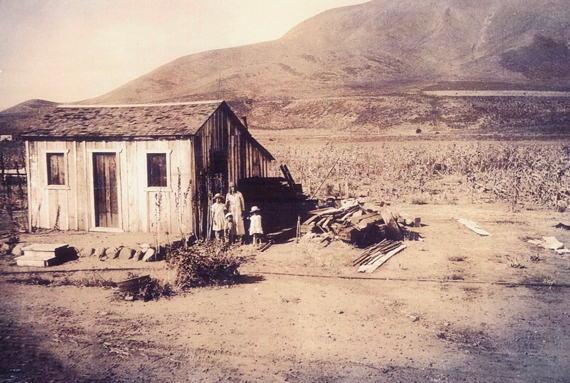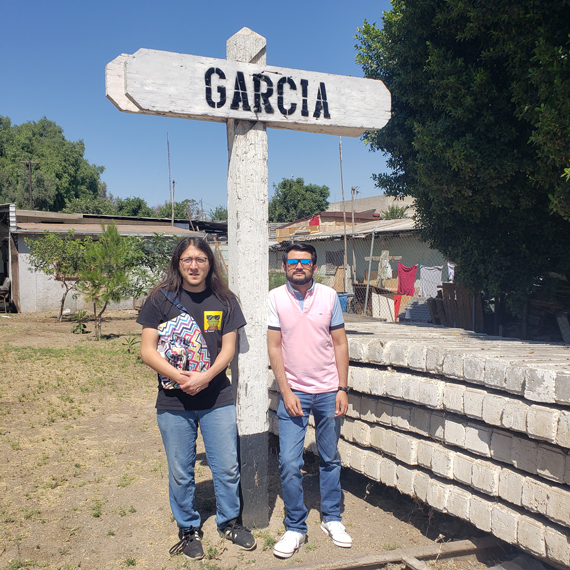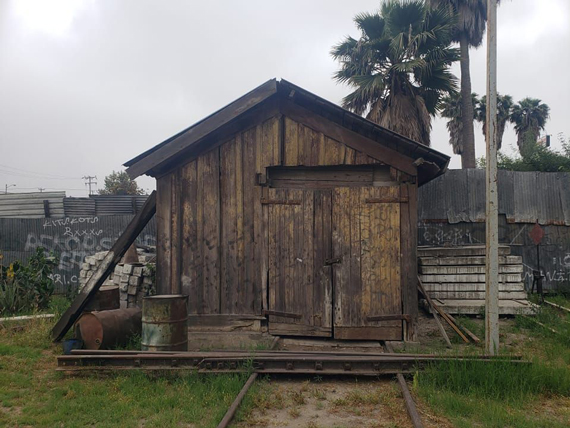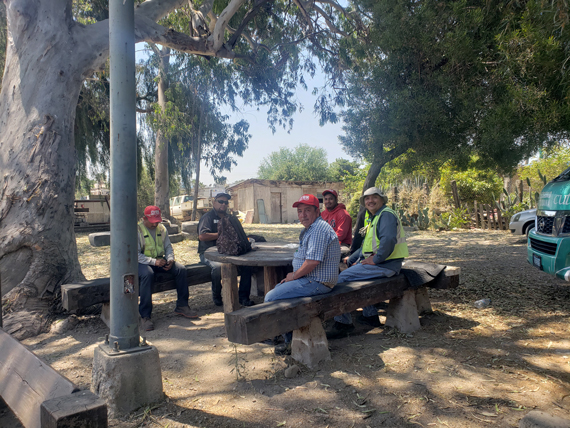|
The Potential for Tijuana’s García Station
By Maria E Curry
January/February 2024
 This undated photo from the historic archive in Tijuana shows a farmer's family at the base of Cerro Colorado Mountain. Behind them, there appears to be a corn field or vineyard, according to the archive's information. A similar view of the mountain can be seen from García Station, which may be designated a state cultural heritage site. Courtesy Tijuana Historic Archive |
 Josue Amor and Víctor Mujica, two model railroad enthusiasts from Tijuana, stand in front of the García Station sign post at kilometer 13.9 of the Tijuana and Tecate railroad. Behind them, we can see concrete ties to repair the tracks, a structure used by railroad workers, and houses for former employees, separated by a fence. Photo by Maria Curry |
 After restoration, this old wood structure could be adaptively reused as part of the proposed new railway museum. Originally, it housed a service car that repaired the train tracks. Photo by Maria Curry |
 Railroad workers enjoy having lunch outside at García Station. The compound has little use today and lends itself to becoming a railway museum and park-like garden for neighbors and visitors alike. The area includes mature trees, native vegetation, scenic views, and seven structures that could be restored, rehabilitated, or renovated. Photo by Maria Curry |
The historic García train station in Tijuana, Baja California, can be designated as a state cultural heritage site (with a period of significance of 1921-1970) and has promising potential to become a railway museum and garden. Toward this goal, I have been researching this property’s chronological changes and transformational events.
The García Station complex, at kilometer 13.9 of the Tijuana and Tecate (T&T) railroad line (1907-1919), stands in the middle of factories and densely populated neighborhoods. Seven of its structures are used for storage and offices, with two of them more than 100 years old. Old trees, native vegetation, and scenic views, including the iconic Colorado Mountain, make the place feel almost rural, which in fact it was more than a century ago. The railway’s tunnel #1 (1910), with its beautiful stone portal, is a few miles south of the station. However, the vicinity is affected by graffiti street art and individuals without permanent housing who gather along the tracks.
Historically, the area has ancestral value for the indigenous Yuman peoples. In the 1920s, the place was called Rancho Cerro Colorado, where some 500 horses and cattle grazed. Later, it was renamed Rancho García for the 1860 owner, Don Santiago García, hence the station’s name. In 1909, the site became a railroad camp for storing ties, track tools, and other work equipment. A 30,000-gallon water tank, later removed, served the steam locomotives. Workers and officials lived there in wagon trains, with some wagons outfitted as administrative offices. Around 1915, the railroad moved the camp to Tecate, although some railroad workers continued living at García Station until the service was privatized in 1994.
The railroad transformed the rural landscape into an industrial one, and before long, Tijuana grew up around it and absorbed the station. From García Station to Mexicali and back rolled important cargo, including livestock and agricultural and industrial products. The company added passenger service, but later discontinued it.
Today, the line serves the global exportation industries along the T&T as well as the U.S. market, and the station occasionally provides a boarding area for a tourist train to Tecate.
García Station is integral to Tijuana’s social and urban history and to the building of the San Diego and Arizona railroad. With proper identification, evaluation, and interpretation, this railway complex and landscape have the potential to revitalize a marginalized urban area and to connect residents to their history.
|
2025
2024
2023
2022
2021
2020
2019
2018
2017
2016
2015
|







